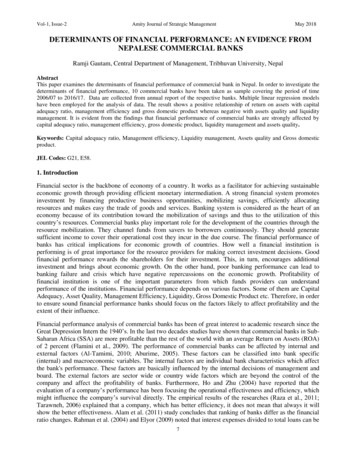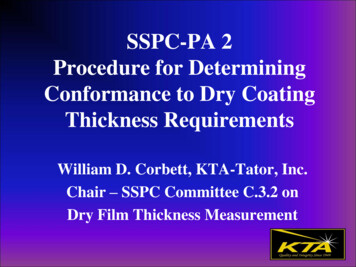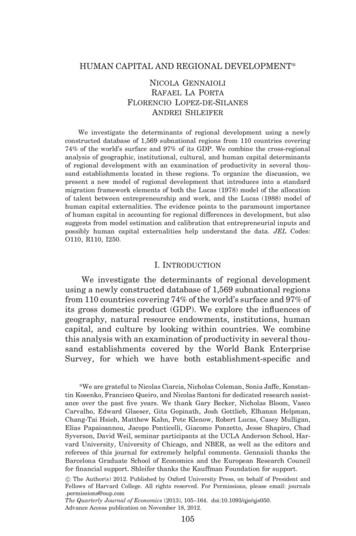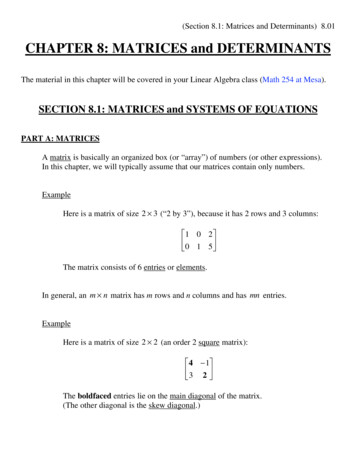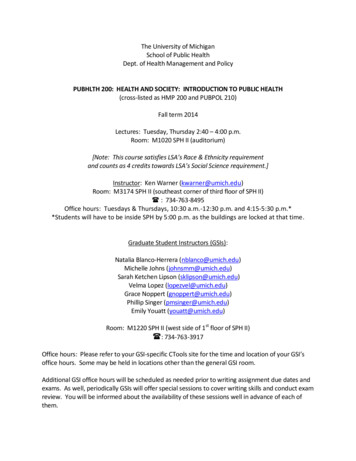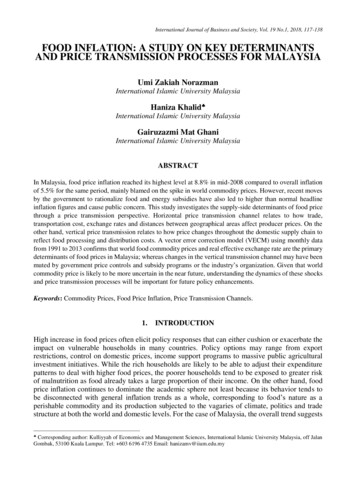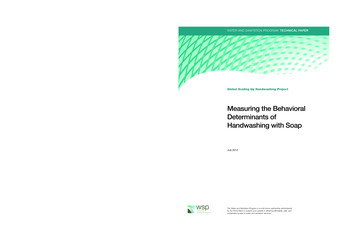
Transcription
WATER AND SANITATION PROGRAM: TECHNICAL PAPERGlobal Scaling Up Handwashing ProjectMeasuring the BehavioralDeterminants ofHandwashing with SoapJuly 2012The Water and Sanitation Program is a multi-donor partnership administeredby the World Bank to support poor people in obtaining affordable, safe, andsustainable access to water and sanitation services.8393-COVR.pdf i7/9/12 4:05 PM
By Orlando Hernandez, Jacqueline Devine, Jonathan Karver, Claire Chase,and Yolande CoombesThe authors are grateful for the work done by the monitoring and evaluation staffand consultants at the country level, which made possible the implementation ofthe research discussed in this document. We also express our gratitude to MeganLitrell, Steve Chapman, and Kim Longfield from Population Services Internationalfor their contributions as peer reviewers. These contributions helped to improvethis Technical Paper, making it more focused, more user-friendly, and more relevantfor future applications.Global Scaling Up Handwashing is a Water and Sanitation Program (WSP)project focused on applying innovative behavior change approaches to improvehandwashing with soap behavior among women of reproductive age (ages 15-49)and primary school-age children (ages 5-9). It is being implemented by local andnational governments with technical support from WSP in four countries: Peru,Senegal, Tanzania, and Vietnam. For more information, please visit www.wsp.org/scalinguphandwashing.This Technical Paper is one in a series of knowledge products designed to showcaseproject findings, assessments, and lessons learned in the Global Scaling UpHandwashing Project. This paper is conceived as a work in progress to encouragethe exchange of ideas about development issues. For more information pleaseemail Orlando Hernandez at wsp@worldbank.org or visit www.wsp.org.WSP is a multi-donor partnership created in 1978 and administered by the World Bank to supportpoor people in obtaining affordable, safe, and sustainable access to water and sanitation services.WSP’s donors include Australia, Austria, Canada, Denmark, Finland, France, the Bill & Melinda GatesFoundation, Ireland, Luxembourg, Netherlands, Norway, Sweden, Switzerland, United Kingdom,United States, and the World Bank.WSP reports are published to communicate the results of WSP’s work to the development community.Some sources cited may be informal documents that are not readily available.The findings, interpretations, and conclusions expressed herein are entirely those of the author andshould not be attributed to the World Bank or its affiliated organizations, or to members of the Boardof Executive Directors of the World Bank or the governments they represent. The World Bank doesnot guarantee the accuracy of the data included in this work.The material in this publication is copyrighted. Requests for permission to reproduce portions ofit should be sent to wsp@worldbank.org. WSP encourages the dissemination of its work and willnormally grant permission promptly. For more information, please visit www.wsp.org. 2012 Water and Sanitation Program8393-COVR.pdf ii7/9/12 4:05 PM
Global Scaling Up Handwashing ProjectMeasuring the BehavioralDeterminants ofHandwashing with SoapOrlando Hernandez, Jacqueline Devine, Jonathan Karver,Claire Chase, and Yolande CoombesJuly 20128393-FM.pdf i7/9/12 4:04 PM
8393-FM.pdf ii7/9/12 4:04 PM
Executive SummaryBackgroundThis Technical Paper presents lessons learned from the application of the Focus, Opportunity, Ability, and Motivation(FOAM) framework to identify handwashing determinantsThe analysis presented used data derived from formativeresearch studies, monitoring surveys, and impact evaluationbaseline studies conducted by the Water and SanitationProgram (WSP) through its Global Scaling Up Handwashing Project. That project (2007–2012) was implemented bynational and local national governments in Peru, Senegal,Tanzania, and Vietnam with technical support from WSP.The discussion focuses on findings from the analysis ofdata collected in Peru and Senegal and provides practicalrecommendations for researchers and program managersworking in handwashing promotion. In addition to offering a rationale for measuring handwashing determinants,the paper describes the FOAM framework and details theprocess used to measure the determinants, focusing on lessons learned.MethodologyTo design an effective handwashing promotion intervention, it is essential to identify the triggers of that practice.The identification of handwashing behavioral determinantsinforms the design of communication strategies, and it isuseful to track their effectiveness, particularly to determineif the triggers were mobilized and if they influenced targeted practices.Existing research, has identified five critical handwashingjunctures for child caretakers: after cleaning a child’s bottom,after defecation,before preparing food,before feeding a child, andbefore eating.These junctures are essential components of handwashing promotion programs to reduce diarrhea among children. This paper seeks to address whether and how thewww.wsp.org8393-FM.pdf iiideterminants of handwashing with soap vary across junctures and juncture subcategories (i.e., those associate withfecal contact versus those associated with food handling).Because the frequency of handwashing varies across junctures and settings, establishing which determinants comeinto play each time suggests the need to contextualize handwashing promotion programs.In the context of the FOAM framework, focus identifies theactions to be performed and the actors who should perform them; opportunity identifies the chances to performthe actions and the availability of required resources; ability addresses individual and contextual factors that makethe action’s performance possible; and motivation identifiespsycho-social factors and the extent to which performingthe desired action is in the individual’s best interest.To identify handwashing determinants, the FOAM framework’s components were broken down into subcomponentsbased on the specific context and identified junctures. Thefollowing subcomponents constituted the handwashingdeterminants: target behavior and target population (focus); access/availability, product attributes, and socialnorms (opportunity); knowledge and social support (ability); and belief/attitudes, outcome expectations, threat, andintention (motivation).Using PSI’s Tracking Results Continuously (TRaC) methodology as a guide, WSP measured the determinants of handwashing with soap using the following six-step approach: Develop statements to measure the differentdeterminants. Pretest statements using Likert-type scales. Modify statements based on the pretest. Conduct a pilot study with a larger (preferably random) sample. Construct valid, reliable scales to measure eachdeterminant.iii7/9/12 4:04 PM
Measuring the Behavioral Determinants of Handwashing with SoapExecutive Summary Conduct relevant analysis to determine whether astatistical relationship exists between reliable scalesand the target practice.To monitor changes in handwashing determinants, theresearchers looked for changes in mean Likert-type scalescores over time, and examined whether such changeswere associated with exposure to messages disseminatedthrough different channels used in a given communicationintervention.Lessons LearnedThis Technical Paper focuses on the lessons learned in applying the six-step methodology in Peru and Senegal, wherea total of eight valid and reliable measures of handwashing determinants were constructed out of 10 considered. Asthe following summary shows, those lessons are organizedinto five categories: instrument design, data collection,scale construction, predicting handwashing, and programfollow-up.Instrument Design When designing instruments (questionnaires) fora specific context, pretesting and piloting are crucial because different country settings offer differentchallenges. To reduce response bias to statements, it might benecessary to test different instrument forms. Translating complex ideas and adapting them to differentlanguages and cultural settings can be difficult, sotranslators should be skilled at both linguistic translation and cultural interpretation.Data Collection Pilot studies can help determine the best datagathering strategies for obtaining a good spread ofresponses and avoiding skewedness. To guarantee success, additional quality controlsteps might be needed. Being both cautious andflexible can help you determine whether additionalsafeguards are needed to get the measure right. Follow-up and supervision of data collection fieldwork is crucial, particularly during early stages.iv8393-FM.pdf ivScale Construction Determining validity and reliability of scales are different procedures, and both must be implementedfollowing the PSI protocol. Valid scales might not be reliable scales, and usablescales must be reliable. Statements required to construct valid and reliablescales can vary from country to country.Predicting Handwashing The process will lead to the identification of handwashing predictors. The predictors may vary depending on the context and the juncture. Thus,perfectly valid and reliable scales will be necessarybut not sufficient to predict handwashing practices. Different predictors can be used to attempt prediction of different types of handwashing (after fecalcontact, before food handling, or both). Predictors might perform in an opposite way fromwhat you expect. For example, an increase in threatperceptions might negatively relate to handwashingpractices. Such cases can result from instrumentation issues, but also from the fact that the correlation used to establish predictability is a measure ofassociation but not causality. In this study, the access/availability and habit determinants operated as predictors in more than onesite, whereas six other determinants operated as predictors in one single site and not in the other.Program Follow-Up In follow-up surveys, use only statements that makeup valid and reliable scales, but do not cherrypickitems for monitoring or evaluation purposes. Thekey is to measure the determinant, not the responsesto individual and isolated statements.In addition to discussing these lessons, this Technical Paperhighlights various areas for future research, including theneed to further develop and test the beliefs/attitudes measurement; the importance of the habit measurement—asdefined by the Self-Reported Habit Index (SRHI)—in theFOAM framework context; and the possibility of treatingGlobal Scaling Up Handwashing7/9/12 4:04 PM
Measuring the Behavioral Determinants of Handwashing with SoapExecutive Summaryresponses to items as categorical instead of as continuousvariables when measuring handwashing determinants.In terms of specific guidance for researchers engaging in similar activities, the report offers several key recommendations: Expand the framework’s application in othersites, using items included in the study’s annexesto measure determinants in further field-testingopportunities. If you cannot use all items associated with the determinants in the baseline studies, conduct separateformative research. Before applying this approach, examine items to beused to ensure that testing begins with a single set ofharmonized formulations.www.wsp.org8393-FM.pdf v If the predictors vary by handwashing juncture, explore whether the formulation of items by junctureadds predictive value. Continue testing the SRHI’s utility, but design a setof items that are tested as a generic set across countryapplications.ConclusionsUsing the six-step approach to measure determinants requires rigor, and should not be undertaken without sufficient resources to support the process. At very least,programs considering this approach should be able to accommodate piloting and an adequate sample size, as well asprovide appropriate analytical and statistical skills.v7/9/12 4:04 PM
8393-FM.pdf vi7/9/12 4:04 PM
ContentsExecutive Summary.iiiI.Introduction . 1II.The Global Scaling Up Handwashing Project . 2III. The Rationale for Measuring Handwashing Determinants . 3IV. The FOAM Behavior Change Framework. 4V.Measuring Handwashing with Soap Determinants . 55.1 Developing Items to Measure Handwashing with SoapDeterminants . 55.2 Pretesting Items Using Likert-Type Scales. 85.3 Piloting the Items with a Larger Randomly SelectedSample . 105.4 Constructing Valid and Reliable Scales to MeasureDeterminants . 105.5 Measuring Handwashing with Soap Habit in Peruand Vietnam. 165.6 Using Reliable Scales that Measure Determinantsto Predict Handwashing with Soap . 19VI. Monitoring Changes in Handwashing Determinants . 22VII. Lessons Learned . 247.1 Instrument Design . 247.2 Data Collection and Entry. 257.3 Scale Construction . 257.4 Predicting Handwashing . 257.5 Follow-Up . 257.6 Further Testing . 26VIII. Additional Implications for Replication . 27IX. Conclusion. 28Figure1:FOAM Behavior Change Framework for Handwashingwith Soap . 41:Studies Conducted to Measure HandwashingDeterminants in the Global Scaling Up HandwashingProject . 1Tableswww.wsp.org8393-FM.pdf viivii7/9/12 5:28 PM
Measuring the Behavioral Determinants of Handwashing with Soap2:3:4:5:6:7:8:9:10:11:12:13:14:Executive SummaryItems Used to Measure Social Norms AroundHandwashing with Soap . 6Items Used to Measure Social Support for Handwashingwith Soap . 7Items Used to Measure Beliefs and Attitudes aboutHandwashing with Soap . 8Scoring of Responses to Likert-Type Scale Statements . 8Statements Integrating a Valid Scale to Measure Access/Availability in Peru and Senegal . 12Statements Used to Explore Validity for the Beliefs/Attitudes Scale in Peru and Senegal . 12Statements Comprising a Reliable and Final Scale toMeasure Access/Availability in Peru and Senegal . 13Statements Used to Construct a Reliable and Final Scaleto Measure Beliefs/Attitudes in Peru and Senegal . 14Valid and Reliable Scales Constructed to MeasureHandwashing with Soap Determinants . 15Factor Loadings of Items on Factor Identify WhenMeasuring Habits by Country . 17Items Integrating Reliable and Final Scale of Habits inPeru and Senegal . 18Role of Access, Social Support, and Habits asDeterminants of Handwashing after Fecal Events, beforeFood-Handling Events, or Both in Senegal . 21Average Scores for Access/Availability Scale by Exposure,Peru Tracking Surveys 2009 and 2010 . 23Annexes1:2:3:Example of Questionnaire Used to MeasureOpportunity, Ability, and Motivation in Senegal. 30Example of Instrument to Measure HandwashingDeterminants Used in the Peru Impact Baseline Study . 34Example of Questionnaire Section to Measure HabitsUsed in Peru . 36References . 37viii8393-FM.pdf viiiGlobal Scaling Up Handwashing7/9/12 5:28 PM
I.IntroductionThis document is primarily intended for researchers and monitoring and evaluation specialists working in handwashing promotion, especially those targetingmothers to reduce diarrheal disease among children under five years of age. It mayalso be useful to program managers of handwashing promotion interventionswho are interested in innovative research and monitoring methods.This technical paper captures the lessons generated in the process of measuringhandwashing determinants identified by the Focus, Opportunity, Ability, andMotivation (FOAM) framework. The data presented in this document was obtained through various formative research studies and monitoring surveys, as wellas impact evaluation baseline studies conducted by the Water and Sanitation Program (WSP) as part of its Global Scaling Up Handwashing Project.The document starts with a short introduction to the project, followed by a discussion of the rationale for measuring handwashing determinants. The document provides a brief overview of FOAM prior to detailing the process used tomeasure handwashing determinants, primarily focusing on results from two sites(Peru and Senegal), drawing lessons learned along the way. Table 1 lists the studies, including the country and study sample size, conducted by the project andreferenced in this paper.The document demonstrates how researchers and program managers can use thisapproach to investigate the relationship between determinants and handwashingpractices and track progress as the intervention unfolds.Section 5.5 is devoted to the measurement of the Self Reported Habit Index(SRHI). This section also addresses the relationship between the index and handwashing practices.The conclusion offers a series of practical recommendations for readers seekingto replicate the approach in their programs as part of their formative, monitoringand/or evaluation research. It also addresses the approach’s limitations.TABLE 1: STUDIES CONDUCTED TO MEASURE HANDWASHING DETERMINANTS INTHE GLOBAL SCALING UP HANDWASHING PROJECTCountryPeruStudySample SizeImpact Evaluation Baseline Studyn 3,411Intercept Monitoring Surveys 2009 and 2010n 1,530 (2009)n 1,521 (2010)SenegalDoer/Non-Doer Studyn 1,770VietnamImpact Evaluation Baseline Studyn 3,123www.wsp.org8393-CH01.pdf 117/9/12 4:01 PM
II.The Global Scaling Up Handwashing ProjectDiarrhea is one of the main threats to child health. Washing hands with soap atcritical times—after contact with feces and before handling food—could substantially reduce diarrheal rates by up to 31 percent.1 However, rates of handwashing with soap remain low throughout the developing world and large-scalepromotion of handwashing behavior change is a challenge.A behavioral determinant is anunderlying factor that influenceshandwashing with soap at criticaljunctures.The Global Scaling Up Handwashing Project is a Water and Sanitation Program(WSP)-supported initiative focused on learning how to apply innovative promotional approaches to behavior change in order to generate widespread andsustained improvements in handwashing with soap at scale among women ofreproductive age and primary school-aged children. The project, which will endin 2012, is being implemented by national and local national governments withtechnical support from WSP in Peru, Senegal, Tanzania, and Vietnam.21228393-CH02.pdf 2Waddington et al. 2009For more information, see www.wsp.org/scalinguphandwashingGlobal Scaling Up Handwashing7/9/12 4:01 PM
III.The Rationale for Measuring Handwashing DeterminantsKawata3 and Curtis et al.4 have argued that handwashingserves as both a primary and a secondary barrier to preventthe transmission of diarrheal disease. It serves as a primarybarrier to remove fecal matter after contact with stools, andas a secondary barrier to prevent pathogens from gettinginto food and fluids that will later be consumed by others,allowing pathogens to find new hosts. From this discussion,five critical handwashing junctures for child caretakers havebeen identified as essential components of hygiene promotion programs to reduce diarrhea among children under five: After cleaning a child’s bottom,After defecation,Before preparing food,Before feeding a child, andBefore eating.Although cleansing agents other than soap (e.g., ash orsand) may be used, available research to date is on the impact of handwashing when soap is used.Among the initial steps in designing an intervention tochange handwashing is identifying the factors that determine this practice. From a behavior change perspective,knowing the determinants of handwashing helps: Design more effective communication strategies, and Determine whether handwashing promotion improvedthe factors that influence handwashing with soap.3456Given that handwashing with soap should occur at thejunctures mentioned above, a question that should be answered is whether handwashing with soap is influencedby the same determinants across junctures or if the factorsvary by juncture or by juncture subcategory (i.e., those associated with fecal contact vs. those associated with foodhandling).Exploration of these distinctions will be of significancebecause handwashing across junctures is not practicedwith the same level of frequency across different settings and may need to be contextualized. After observingmainly primary and secondary child caretakers in Kenyanhouseholds, Schmidt et al.5 concluded, for example, thatout of 5,182 opportunities for handwashing, handwashing with soap occurred in only 25 percent of the cases,with 32 percent of caretakers doing so after fecal contactand 15 percent before handling food. In Peru, on theother hand, when a different research methodology wasused, the reverse was detected. Using self reports as handwashing measures, Galiani and Orsola-Vidal6 concludedthat in that same country, handwashing with soap is morecommon at the time of cooking (68 percent) than afterdefecation (46 percent), after cleaning a child’s bottom(42 percent), or even before feeding a child (34 percent).Although methodologies could influence the differences,what remains true is that regardless of how you measurethe behavior, handwashing at critical junctures remainsuneven.Kawata 1978Curtis, Cairncross, and Yonli 2000Schmidt et al. 2009Galiani and Orsola-Vidal 2010www.wsp.org8393-CH03.pdf 337/9/12 4:01 PM
IV.The FOAM Behavior Change FrameworkTo identify determinants that influence handwashing, theproject uses the Focus, Opportunity, Ability, and Motivation (FOAM) framework.7 Components of this model arepresented in Figure 1. This framework has been used inother global health interventions, mainly by PopulationServices International (PSI), and is based on the originalwork proposed by Rothschild.8 Succinct definitions of theframework’s components follow: Focus refers to the fact that a behavior change intervention must clearly identify what actions shouldbe performed and who should perform them. Ajzenand Fishbein9 argue that the definition of behaviorsmust include not only the action to be performed(handwashing), but also the context in which it isperformed (such as after defecation or before eating). The target audience for handwashing practices may be, for example, primary or secondarycaretakers of children under a certain age or evenproviders delivering babies or caring for newbornchildren. Opportunity refers to the chance that the behavior be performed and includes the resources neededto perform the behavior. Under this category, onemay find external factors over which individuals expected to engage in the behavior may have little orno control. Ability includes individual and contextual factors thatmake the performance of a given action possible. At thecontextual level, it may include social support needed toengage in the action, and at the individual level it mayinclude skills and proficiencies to perform the action. Motivation includes psycho-social factors and is associated with the extent to which performing thedesired action is in the individual’s best interest.Coombes and Devine have argued that motivationhas a direct influence on behavior, yet this influenceis moderated by both opportunity and ability.Figure 1 contains a breakdown of the different model components into subcomponents. In this paper, we refer tothose subcomponents as handwashing determinants.This framework permits program managers and researchersto have needed flexibility in identifying handwashing determinants because factors that influence handwashing—or anybehavior for that matter—may be content as well as juncturespecific. That is, handwashing determinants that operate ina given country setting might not operate in another. By thesame token, handwashing determinants that influence onejuncture might not influence another. The measurement ofdeterminants suggested by this framework in three different countries and in connection with different handwashingjunctures will allow us to see if this in fact the case.FIGURE 1: FOAM BEHAVIOR CHANGE FRAMEWORK FOR HANDWASHING WITH ailabilityKnowledge789SocialnormsBelief onCoombes and Devine 2010; see SP IntroducingFOAM HWWS.pdfRothschild 1999Ajzen and Fishbein 198048393-CH04.pdf 4Global Scaling Up Handwashing7/9/12 4:02 PM
V.Measuring Handwashing with Soap DeterminantsThe measurement of handwashing determinants requires certain steps. Thesesteps, which have been detailed elsewhere, address the approach developed by PSIas part of their Tracking Results Continuously (TRaC) methodology.10 For PSI,data collection on determinants is done as part of formative research for audiencesegmentation as well as for monitoring and evaluation purposes, and it is usefulin program planning and decision-making. This is also true in the context of theGlobal Scaling Up Handwashing Project. The examples described in this sectionwere implemented for audience segmentation purposes, as was the case of theSenegal where a doer/non-doer study was conducted to identify the determinantsassociated with handwashing with soap, but also for monitoring and evaluationpurposes, as was the case for Peru.PSI uses a rigorous process of scale construction. Details about the full-blownprocess can be found in the references cited above. For brevity, the major steps ofthe methodology used as part of this exercise in the context of the WSP GlobalScaling Up Handwashing Project can be summarized as follows: Develop statements to measure the different determinants.Pretest statements using Likert-type scales.Modify statements based on the pretest.Conduct a pilot study with a larger sample, preferably selected at random.Construct valid and reliable scales to measure each determinant (validityand reliability require different procedures to represent substeps withinscale construction). Conduct relevant tests to determine whether a statistical relationship existsbetween reliable scales and the practice of interest.A scale is a measure of an attributeor a construct through the use ofstatements that when put togetherhelp identify an underlying dimension.Scales used in this paper areconsidered to be interval scales andare helpful in calculating scores thatcan be used in classifying individualsor studying relationships betweenprogram components throughstatistical analysis.A short discussion on each of these steps follows.5.1 Developing Items to Measure Handwashing with SoapDeterminantsKey Steps Start with a generic list of items per determinant. Add country-specific items to the list to make it relevant. Translate and back translate items to be pretested. Addition of country-specific items does not guarantee that they will be empirically integrated to a scale or predict practices, but it might permit the scale tobe sensitive to local context.10K. O’Connell et al. 2006; Lipovsek et al. 2006a; Lipovsek et al 2006b; Yang et al. 2007www.wsp.org8393-CH05.pdf 557/9/12 4:02 PM
Measuring the Behavioral Determinants of Handwashing with SoapMeasuring Handwashing with Soap DeterminantsThe first step in measuring determinants required that theGlobal Scaling Up Handwashing Project develop statements for use in different types of surveys (e.g., householdor intercept). These statements were developed based onpreviously conducted formative research and on the experience of program managers and researchers. The list ofstatements per determinant included both generic andcountry-specific items. Statements were contextualized sothey would make sense and be relevant to the communitieswhere the programs were to be implemented. As the methodology used to measure determinants suggests, seven to10 items were identified per FOAM subcomponent andincorporated into survey instruments prior to pretest.The project first developed a generic list of statements thatcould be used in the various countries. Statements developedhad positive and negative formulations. A positive formulation was one in which the statement was written to reflectthe program’s objectives. This is the case with Statement 3 inTable 2: “In most homes in my community, s
this Technical Paper, making it more focused, more user-friendly, and more relevant for future applications. Global Scaling Up Handwashing is a Water and Sanitation Program (WSP) project focused on applying innovative behavior change approaches to improve handwashing with soap


